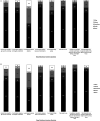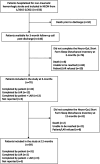An Exploratory Analysis of Preclinical and Clinical Factors Associated With Sleep Disturbance Assessed via the Neuro-QoL After Hemorrhagic Stroke
- PMID: 38895018
- PMCID: PMC11181970
- DOI: 10.1177/19418744241231618
An Exploratory Analysis of Preclinical and Clinical Factors Associated With Sleep Disturbance Assessed via the Neuro-QoL After Hemorrhagic Stroke
Abstract
Background and purpose: Sleep disturbance after hemorrhagic stroke (intracerebral or subarachnoid hemorrhage) can impact rehabilitation, recovery, and quality of life. We sought to explore preclinical and clinical factors associated with sleep disturbance after hemorrhagic stroke assessed via the Quality of Life in Neurological Disorders (Neuro-QoL) short form sleep disturbance inventory.
Methods: We telephonically completed the Neuro-QoL short form sleep disturbance inventory 3-months and 12-months after hemorrhagic stroke for patients >18-years-old hospitalized between January 2015 and February 2021. We examined the relationship between sleep disturbance (T-score >50) and social and neuropsychiatric history, systemic and neurological illness severity, medical complications, and temporality.
Results: The inventory was completed for 70 patients at 3-months and 39 patients at 12-months; 18 (26%) had sleep disturbance at 3-months and 11 (28%) had sleep disturbance at 12-months. There was moderate agreement (κ = .414) between sleep disturbance at 3-months and 12-months. Sleep disturbance at 3-months was related to unemployment/retirement prior to admission (P = .043), lower Glasgow Coma Scale score on admission (P = .021), higher NIHSS score on admission (P = .041) and infection while hospitalized (P = .036). On multivariate analysis, sleep disturbance at 3-months was related to unemployment/retirement prior to admission (OR 3.58 (95% CI 1.03-12.37), P = .044). Sleep disturbance at 12-months was related to premorbid mRS score (P = .046).
Conclusion: This exploratory analysis did not demonstrate a sustained relationship between any preclinical or clinical factors and sleep disturbance after hemorrhagic stroke. Larger studies that include comparison to patients with ischemic stroke and healthy individuals and utilize additional techniques to evaluate sleep disturbance are needed.
Keywords: intracerebral hemorrhage; modified Rankin scale score; sleep; subarachnoid hemorrhage; unemployment.
© The Author(s) 2024.
Conflict of interest statement
The author(s) declared no potential conflicts of interest with respect to the research, authorship, and/or publication of this article.
Figures




Similar articles
-
Pharmacotherapies for sleep disturbances in dementia.Cochrane Database Syst Rev. 2016 Nov 16;11(11):CD009178. doi: 10.1002/14651858.CD009178.pub3. Cochrane Database Syst Rev. 2016. Update in: Cochrane Database Syst Rev. 2020 Nov 15;11:CD009178. doi: 10.1002/14651858.CD009178.pub4. PMID: 27851868 Free PMC article. Updated.
-
Systemic and topical antibiotics for chronic rhinosinusitis.Cochrane Database Syst Rev. 2016 Apr 26;4(4):CD011994. doi: 10.1002/14651858.CD011994.pub2. Cochrane Database Syst Rev. 2016. PMID: 27113482 Free PMC article.
-
Reminiscence therapy for dementia.Cochrane Database Syst Rev. 2018 Mar 1;3(3):CD001120. doi: 10.1002/14651858.CD001120.pub3. Cochrane Database Syst Rev. 2018. PMID: 29493789 Free PMC article.
-
Systemic pharmacological treatments for chronic plaque psoriasis: a network meta-analysis.Cochrane Database Syst Rev. 2021 Apr 19;4(4):CD011535. doi: 10.1002/14651858.CD011535.pub4. Cochrane Database Syst Rev. 2021. Update in: Cochrane Database Syst Rev. 2022 May 23;5:CD011535. doi: 10.1002/14651858.CD011535.pub5. PMID: 33871055 Free PMC article. Updated.
-
Yoga for stroke rehabilitation.Cochrane Database Syst Rev. 2017 Dec 8;12(12):CD011483. doi: 10.1002/14651858.CD011483.pub2. Cochrane Database Syst Rev. 2017. PMID: 29220541 Free PMC article.
References
LinkOut - more resources
Full Text Sources
